
Munich is the capital and most populous city of the Free State of Bavaria, Germany. With a population of 1,589,706 inhabitants as of 29 February 2024, it is the third-largest city in Germany, after Berlin and Hamburg, and thus the largest which does not constitute its own state, as well as the 11th-largest city in the European Union. The city's metropolitan region is home to about 6.2 million people and the third largest metropolitan region by GDP in the European Union.
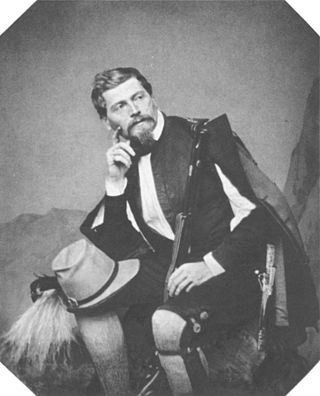
Ludwig Samson Heinrich Arthur Freiherr von und zu der Tann-Rathsamhausen was a Bavarian general.
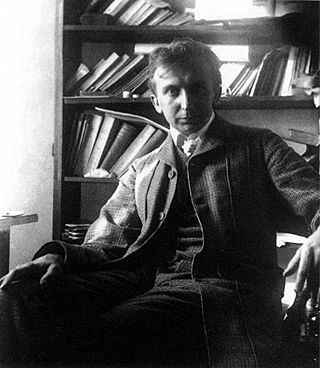
August Endell was a designer, writer, teacher, and German architect. He was one of the founders of the Jugendstil movement, the German counterpart of Art Nouveau. His first marriage was with Elsa von Freytag-Loringhoven.

Karl-Theodor, Duke in Bavaria, was a member of the House of Wittelsbach and a professional oculist. He was the favorite brother of the Empress Elisabeth of Austria, and father of Queen Elisabeth of the Belgians.
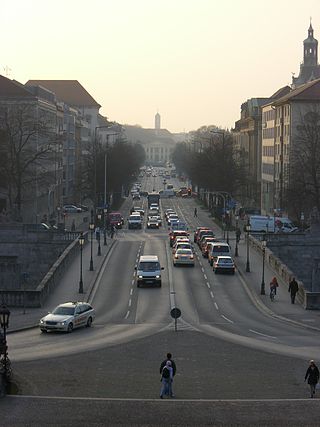
The Prinzregentenstraße in Munich is one of four royal avenues and runs parallel to Maximilianstraße and begins at Prinz-Carl-Palais, in the northeastern part of the Old Town. The avenue was constructed from 1891 onwards as a prime address for the middle-class during the reign of Luitpold, Prince Regent of Bavaria and is named in his honour. The square in the eastern part of the street is named Prinzregentenplatz.

Prince Alfons of Bavaria was a member of the Bavarian Royal House of Wittelsbach and a General of Cavalry.

The Consulate General of the United States, Munich represents the interests of the United States government in Bavaria, Germany. Headed by the Consul General, the Consulate provides services to Americans in Bavaria and fostering Bavarian-American relations.
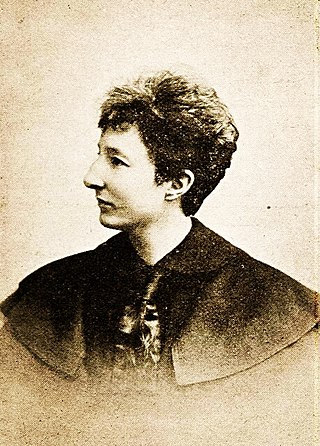
Anita Theodora Johanna Sophie Augspurg was a German jurist, actress, writer, activist of the radical feminist movement and a pacifist.

Josef Bernhard Maria Bleeker was a German sculptor.

The Villa Stuck, built in 1898 and established as a museum in 1992 and located in the Munich quarter of Bogenhausen, is a museum and historic house devoted to the life and work of the painter Franz Stuck. In contrast to the Classical architecture of the exterior, Stuck decorated the interior in striking Art Nouveau/Art Deco style.

The Palais Ludwig Ferdinand is an early 19th-century palace in Munich, Germany, designed by Leo von Klenze. It is located on the Wittelsbacherplatz but forms part of an ensemble with the buildings on the west side of the Odeonsplatz. It was Klenze's own residence, then belonged to Princes Alfons and Ludwig Ferdinand of Bavaria. It is now the headquarters of Siemens.

The Munich Secession was an association of visual artists who broke away from the mainstream Munich Artists' Association in 1892, to promote and defend their art in the face of what they considered official paternalism and its conservative policies. They acted as a form of cooperative, using their influence to assure their economic survival and obtain commissions. In 1901, the association split again when some dissatisfied members formed the group Phalanx. Another split occurred in 1913, with the founding of the New Munich Secession.
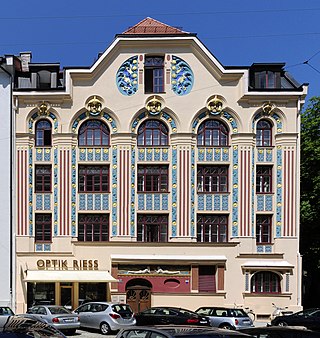
Ernst Haiger was a German architect.

Sophia Goudstikker was a Dutch-born German photographer and feminist pioneer. She was one of the premier women's rights activists in Munich at the turn of the century and a business partner and companion of Anita Augspurg. When their partnership dissolved, Goudstikker became a more moderate feminist and partnered with Ika Freudenberg. Goudstikker was the inspiration for three different writers' depictions of a more masculine woman, who defied typical feminine characterizations. She was the first unmarried German woman to obtain a royal license for photography and the first German woman allowed to argue cases before the youth court.

Friederike, called Ika Freudenberg was a leading protagonist of the women's movement in Bavaria.

The following outline is provided as an overview of and topical guide to Munich:

The Königinstraße is a street in Munich. It runs west of the Englischer Garten from the Von-der-Tann-Straße in the district of Maxvorstadt, to the north and to the Maria-Josepha-Straße and Mandlstraße in the Ensemble Alt-Schwabing.

The Bundesstraße 304 is a German federal highway that runs from Dachau north of Munich through the Bavarian capital via Ebersberg, Wasserburg am Inn and Traunstein to Freilassing on the border with Austria, near Salzburg.
Erwin Schleich was a German architect, architectural conservator, and architectural historian known for his post-war reconstruction of buildings and monuments in Munich.

Emmy von Egidy was a German sculptor and writer.


























